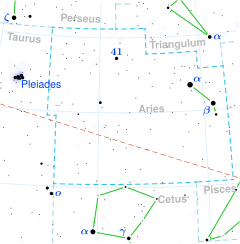Zeta Arietis
| Observation data Epoch J2000 Equinox J2000 | |
|---|---|
| Constellation | Aries |
| Right ascension | 03h 14m 54.09143s[1] |
| Declination | +21° 02′ 39.9952″[1] |
| Apparent magnitude (V) | +4.89[2] |
| Characteristics | |
| Spectral type | A1 V[3] |
| U−B color index | –0.01[2] |
| B−V color index | –0.02[2] |
| Astrometry | |
| Radial velocity (Rv) | +7.0[4] km/s |
| Proper motion ( | RA: –19.930[1] mas/yr Dec.: –72.900[1] mas/yr |
| Parallax ( | 12.7708 ± 0.3734 mas[1] |
| Distance | 255 ± 7 ly (78 ± 2 pc) |
| Absolute magnitude (MV) | +0.35[5] |
| Details | |
| Mass | 2.66±0.07[6] M☉ |
| Luminosity | 73[5] L☉ |
| Temperature | 9,500[7] K |
| Rotational velocity (v sin i) | 133[8] km/s |
| Other designations | |
| Database references | |
| SIMBAD | data |
Zeta Arietis, Latinized from
Name[edit]
This star, along with
In Chinese,
References[edit]
- ^ a b c d e f Brown, A. G. A.; et al. (Gaia collaboration) (August 2018). "Gaia Data Release 2: Summary of the contents and survey properties". Astronomy & Astrophysics. 616. A1. arXiv:1804.09365. Bibcode:2018A&A...616A...1G. doi:10.1051/0004-6361/201833051. Gaia DR2 record for this source at VizieR.
- ^ a b c d Johnson, H. L.; et al. (1966), "UBVRIJKL photometry of the bright stars", Communications of the Lunar and Planetary Laboratory, 4 (99): 99, Bibcode:1966CoLPL...4...99J.
- ^ a b Cowley, A.; et al. (April 1969), "A study of the bright A stars. I. A catalogue of spectral classifications", Astronomical Journal, 74: 375–406, Bibcode:1969AJ.....74..375C, doi:10.1086/110819.
- ^ Wielen, R.; et al. (1999), "Sixth Catalogue of Fundamental Stars (FK6). Part I. Basic fundamental stars with direct solutions", Veroeffentlichungen des Astronomischen Rechen-Instituts Heidelberg, 35 (35), Astronomisches Rechen-Institut Heidelberg: 1, Bibcode:1999VeARI..35....1W.
- ^ a b Anderson, E.; Francis, Ch. (2012), "XHIP: An extended hipparcos compilation", Astronomy Letters, 38 (5): 331, arXiv:1108.4971, Bibcode:2012AstL...38..331A, doi:10.1134/S1063773712050015, S2CID 119257644.
- ^ Zorec, J.; Royer, F. (2012), "Rotational velocities of A-type stars. IV. Evolution of rotational velocities", Astronomy & Astrophysics, 537: A120, arXiv:1201.2052, Bibcode:2012A&A...537A.120Z, doi:10.1051/0004-6361/201117691, S2CID 55586789.
- ^ a b Theodossiou, E.; Danezis, E. (September 1991), "The stellar temperature scale for stars of spectral types from O8 to F6 and the standard deviation of the MK spectral classification", Astrophysics and Space Science, 183 (1): 91–115, Bibcode:1991Ap&SS.183...91T, doi:10.1007/BF00643019, S2CID 119703222.
- ^ a b Royer, F.; Zorec, J.; Gómez, A. E. (February 2007), "Rotational velocities of A-type stars. III. Velocity distributions", Astronomy and Astrophysics, 463 (2): 671–682, arXiv:astro-ph/0610785, Bibcode:2007A&A...463..671R, doi:10.1051/0004-6361:20065224, S2CID 18475298
- ^ "zet Ari". SIMBAD. Centre de données astronomiques de Strasbourg. Retrieved 2012-08-04.
- ^ "The Colour of Stars", Australia Telescope, Outreach and Education, Commonwealth Scientific and Industrial Research Organisation, December 21, 2004, archived from the original on 2013-12-03, retrieved 2012-01-16
- ^ Allen, R. H. (1963), Star Names: Their Lore and Meaning (Reprint ed.), New York, NY: Dover Publications Inc, p. 83, ISBN 0-486-21079-0, retrieved 2010-12-12.
- ^ Rhoads, Jack W. (November 15, 1971), Technical Memorandum 33-507-A Reduced Star Catalog Containing 537 Named Stars (PDF), Jet Propulsion Laboratory, California Institute of Technology.
- ^ (in Chinese)
中國 星座 神話 , written by陳 久金 . Published by台灣 書房 出版 有限 公司 , 2005, ISBN 978-986-7332-25-7. - ^ (in Chinese) AEEA (Activities of Exhibition and Education in Astronomy)
天文 教育 資 訊網 2006年 5月 22日

